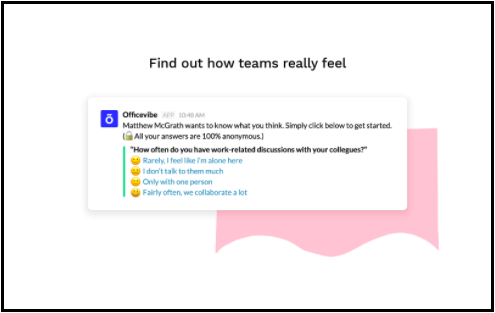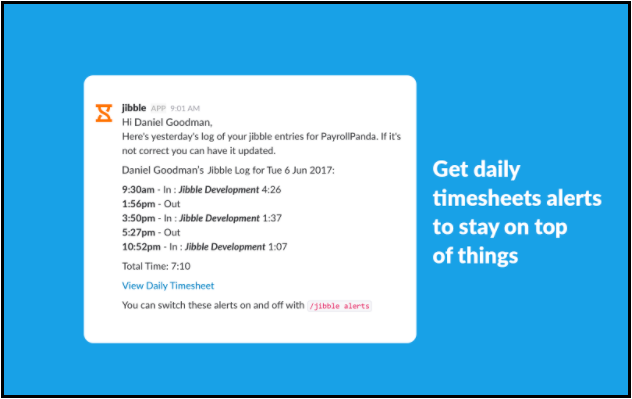Slack has helped transform the way organizations coordinate with team members and manage remote employees. As teams started working remotely, this application helped streamline engagement with employees.
Apart from the basic functionalities of this app, Slack offers a great number of optimization tools to improve your business functions, especially with remote work. Slack has tried to tick off every aspect of building highly-functional virtual office spaces.
The Top Slack Optimization Tools
Officevibe
A team engagement tool, Officevibe helps employers get insights from their workforce. These insights can be in terms of how they are getting along, the prevailing issues in the workplace, and lack of coordination.
For instance, when you visit the employer’s dashboard, it will highlight the key metrics of employee engagement like satisfaction, happiness, and relationship with their manager. Moreover, it highlights the scores for each metric along with the overall engagement score.
Officevibe also allows leaders to conduct a pulse survey. Through these surveys, you can field questionnaires to find inaccuracies in the way the team is functioning and deploy countermeasures.
Check the snippet below to see what the questions will look like:
Image source: Officevibe
Moreover, Officevibe is a Slack optimization tool for executives to run remote teams as it can help:
- Find issues regarding team collaboration by allowing employees to express their opinions.
- Boost morale by encouraging employee recognition and engagement.
- Make changes in the company as per the feedback received from the workers.
Jibble
A time optimization tool, Jibble allows employers to track the login and log out timings of their employees. You can use it by giving simple input commands such as “in” and “out”. Such simple instructions make it very easy to operate.
This Slack optimization tool allows leaders to access the logs or timesheets by which you can check the working hours of the employees. This may seem like a micromanagement tool. But, it can be immensely useful. So, you need to make sure that you use it in that manner.
For instance, let’s say you have a writing team that has to conduct the following tasks:
- Drafting the Blog
- Editing & Proofreading
- SEO & Image Optimization
- Uploading Content to the Website
- Sharing the Blog Post on Social Media
If an employee is working on the “SEO & Image Optimization” task, all they need to do is input “in” followed by the number “3”.
Executives can track the timesheets on the Jibble website and assess the time being spent on such tasks and find the weak areas to improve operational efficiency.
Image source: Jibble
Karma
Karma is a human resources tool and bot that aims to improve team engagement. It follows a points-based performance approach to enhance the practices of rewarding employees. Essentially, it can help you improve the performance of your workers and embolden your business leader resume.
It allows team members to share their Karma Points and the rewards are instant since it is a bot. It helps executives gather feedback from the chats. They can examine the performance graph of the employees and identify the areas that need improvement.
But, the great thing about Karma is that it is mutually beneficial Slack optimization tool. It rewards employees for good work and creates performance reports for the managers.
To download this, all you need to do is visit the Slack application store. Here is what it will look like:
Image source: Karmabot
ToDoBot
ToDoBot allows employers to assign tasks to team members on Slack. Since it is a bot, all you need to do is input the task details in the message box.
Let’s say you are discussing a project and you need to have “X-employee” to work on the task “Testing of new features”. You can assign the task without leaving Slack. Go to ToDoBot and write “Testing of new features @X-employee”. But, there are various ways you can use this: Person @todobot, /todo command, message action, @todobot, etc.
The idea is that it sidelines the need for using a project management tool that requires a good amount of time to create a task. It also helps share the developments of the projects to involved stakeholders and clients. You can keep them in the loop and create a transparent roadmap for the deliverables all through this one Slack optimization tool.
Image source: ToDoBot
Dash
Slack can get really messy with a ton of channels or groups and personal chats options. Dash helps you organize your virtual workspace by helping you make temporary channels that are time-bound so that the main groups do not get cluttered.
This Slack optimization tool is ideal for temporary tasks. Let’s say a team of six members needs to work on testing. You can create a Dash channel and set the expiration date. Once the task is complete, the channel will disappear on its own.
To use Dash, all you need to do is input the “/dash command” following which you can create the channel and add members. For example: “/dash [Testing] [@Person1 @Person2]”.
Image source: Dash
Highlights of Slack Optimization Tools
Here are a few highlights from the article:
- Use Officevibe to create frequent surveys and bolster engagement with your employees.
- Add Jibble to identify inaccuracies in the team functions.
- Improve the performance of your employees by using Karma for employee recognition.
- Assign tasks to your team members via ToDoBot and without leaving the Slack channel.
- Create temporary channels by using Dash for short term tasks.












